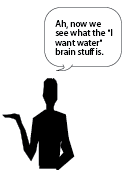The water-seeker thought experiment only makes sense given its unstated premise that the "I want water" thought is actually accessible to consciousness.
Without this premise, there would be no way for scientists to make a correlation between the "I want water" neurophysiology and the "I want water" conscious experience.
For the thought experiment to make sense, we must assume that at some point someone consciously experiences the "I want water thought" while being monitored by a brain-o-scope.

John Searle (1990a).
Note: For a description of the brain-o-scope see "Rejection of supervenience is unacceptable", Box 46.